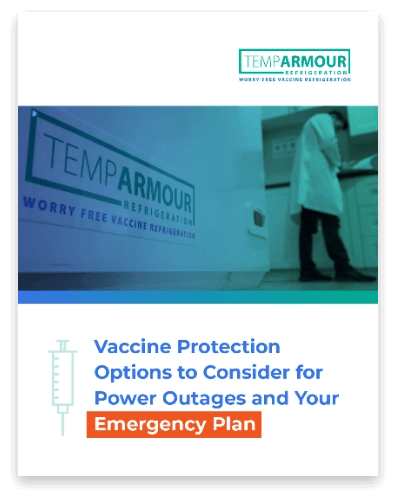 Vaccine refrigerators need to reliably and consistently keep their temperature within the required 36-46°F (2-8°C) range to ensure that the integrity of refrigerated vaccines is maintained. This is true, not only when a vaccine refrigerator is closed but also throughout the day when it is being opened to access vaccines.
Vaccine refrigerators need to reliably and consistently keep their temperature within the required 36-46°F (2-8°C) range to ensure that the integrity of refrigerated vaccines is maintained. This is true, not only when a vaccine refrigerator is closed but also throughout the day when it is being opened to access vaccines.
Purchasing a vaccine refrigerator with the following features will go a long way in avoiding cold chain incidents and vaccine losses later on. We explain below how 3 of the TempArmour™ Vaccine Refrigerator’s features contribute to improved vaccine storage conditions. This is something that TempArmour™ customers experience everyday (see our customer testimonials).
Feature #1 Upright vs Chest Style
A big challenge with upright vaccine refrigerators is that they open from the front. When the door is opened, temperature-regulated air rushes out and warmer ambient air from the room enters the fridge. This upright design is notorious for resulting in wide temperature fluctuations in the fridge.
In contrast, a top opening, chest style cabinet design contributes to a stable temperature within the fridge. Since cold air is heavier than warm air, the chest style vaccine refrigerator is effective at retaining the cooler 36-46°F (2-8°C) air in the fridge when it is opened and closed throughout the day.
Feature #2 Insulated Cabinet and Doors vs Glass Doors
There are essentially two types of vaccine refrigerator cabinets available. One is the more traditional insulated refrigerator with an insulated cabinet and doors, and a polymer or metal exterior. The other type is vaccine refrigerators that have glass doors. Glass doors became a popular feature for upright vaccine refrigerators to try to mitigate the fact that practitioners need to get in and out of upright refrigerators as quickly as possible to minimize the amount of temperature fluctuation within the fridge as described above (in Feature #1).
Unfortunately, glass doors on vaccine refrigerators create a whole new set of issues that lead to cold chain incidents and vaccine losses.
Typical vaccine refrigerators with glass doors do not have an energy efficient shell, and therefore consume much more power to maintain the required temperature within the fridge.
Besides costing significantly more to operate, vaccine fridges with glass doors go out of range very quickly, usually within a couple of hours, in the event of a disruption to power (e.g., blackout or cord unplugged) or if the fridge should stop operating due to any other reason, e.g. equipment malfunction. In contrast, the TempArmour™ Vaccine Refrigerator will maintain its temperature for several days under the same circumstances.
Feature #3 A Quality Min-Max Thermometer and Data Logger
Besides using a well-designed vaccine refrigerator, it is crucial to have accurate temperature readings. It is for this reason, that the TempArmour™ Vaccine Refrigerator is equipped with the highest quality min-max thermometer and data logger that meet all government requirements and recommendations.
The bottom line is if you choose a well-designed vaccine refrigerator with these features in mind, you will have come a long way in avoiding the refrigerated vaccine storage issues and excessive costs that are so common place.

